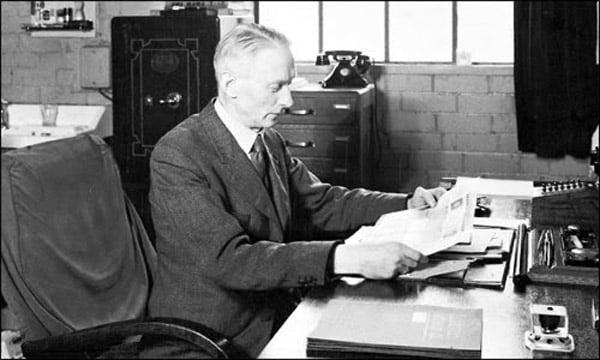 This year we celebrate the work of a great innovator from the audio industry, the Yorkshire man Gilbert Briggs.
This year we celebrate the work of a great innovator from the audio industry, the Yorkshire man Gilbert Briggs.
Britain has an enviable reputation for innovation and quality in audio design. One innovator who could be described as a leading figure in this tradition began work on his first loudspeaker in a small cellar in Ilkley, Yorkshire. It was here that Gilbert Briggs built his first loudspeaker in 1932. Located in the valley of the river Wharfe the company that Briggs and his wife created would soon become world famous as the brand Wharfedale.
Gilbert Briggs is still much admired and respected throughout the world for his pioneering work in hifi reproduction and his endless pursuit of better sound quality driven by his love of live music.
A brief look at the history of the Briggs of Yorkshire, because it was very much a husband and wife operation and the history of the company would need to begin in 1933 when Gilbert set up a small factory near Bradford to build loudspeaker drive units for the emerging technology, radio. As demand grew for the new drive units his wife, Doris Edna Briggs took control of the ever increasing production demands.
Notably in the same year the company won first and second prize in the Bradford Radio Society’s annual competition. This led to significant orders and within a short period the company was manufacturing 9000 units a year. Within three years the company had out grown its original site and so moved to a larger factory within Bradford and it was here that the company became part of the War effort producing tens of thousands of transformers for Marconi.
The technological advances that had occurred during the war and the production infrastructure that had been developed made way for a new focus that would take the company forward into high quality audio developments. Responding to the swell of interest after the war in better sound reproduction Briggs turned his attentions to building sophisticated loudspeaker systems that could only be described as High End. The drive unit technology was moving forward thanks to the sophisticated manufacturing techniques that were now finely honed skills. It is reputed that one crossover for one loudspeaker design required two full grown men to lift! Briggs also researched and developed an understanding of the contribution of cabinet structures. Amongst many other novel ideas we can see here the emergence of the the first composite structures.
Briggs brought together plywood skins and filled them with sand to create the first composite structure in loudspeakers. This design was seen as one of the best solutions. The detailed studies of different materials and their comparative strengths and weaknesses according to numerous criteria were all documented and would eventually find there way into publication. In fact some of the findings of his research work he openly shared when he published in 1948 his first book, ‘Loudspeakers The Why & How of Good Reproduction’. Though modest in size the first edition was so well received, it sold out within 5 months and has subsequently been reprinted on numerous occasions. He went on to write many other books, including the follow up to Loudspeakers, called ‘Sound Reproduction’.
It was the combination of technologies that enabled the company to set new standards of performance both in the High End and also at more affordable prices. It could be said that Briggs introduced the idea of the Hi Fi Show when in the 1950’s he decided to present a series of concerts in prestigious concert halls, where live music could be compared to recorded music. The demonstrations were based around a live band, or group of instruments who would play first, being recorded as it happened. The acetate would then be played back to the assembled audience to impress upon them the similarity of the recorded music.
In 1958 The Wharfedale Wireless Works were sold to the Rank organisation. Gilbert Briggs, then 68 years old, continued to manage the day-to-day running of the company until retirement in 1965. He died in 1978. Since then the company has changed hands with various organisations. After Rank came the Verity Group PLC who subsequently sold the company to the Chinese group I.A.G. who also own, Quad, Audiolab, Mission and Castle Acoustics.

